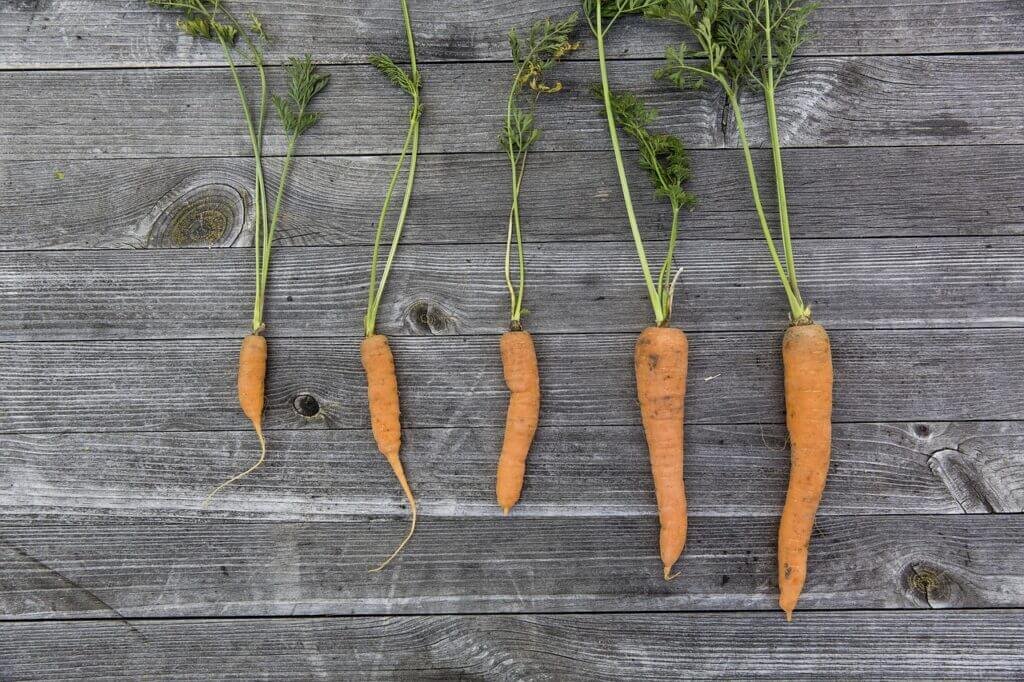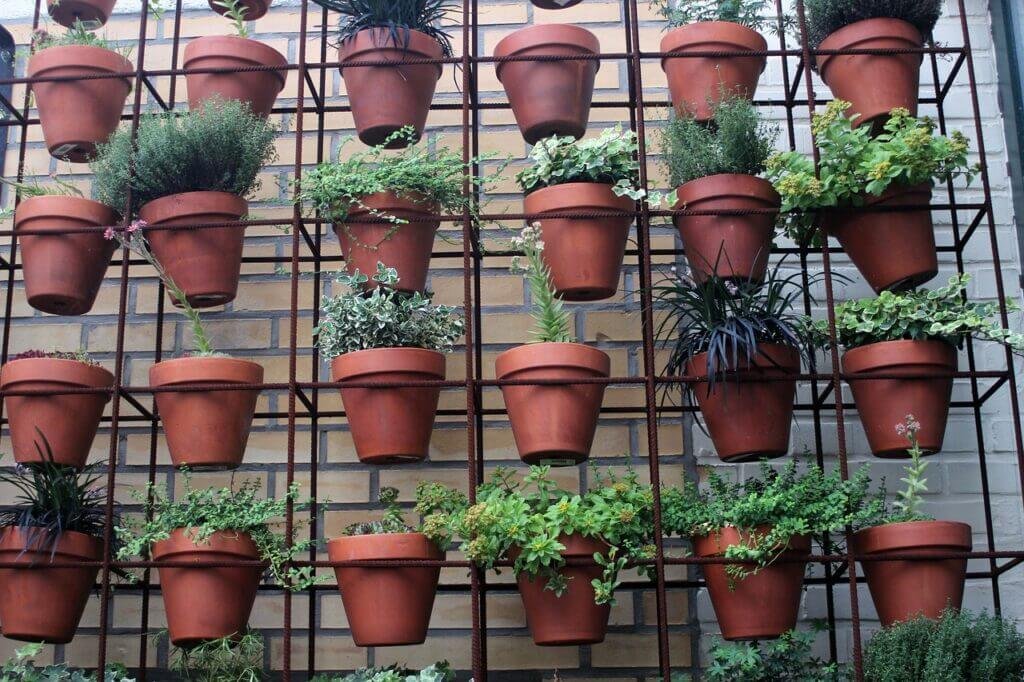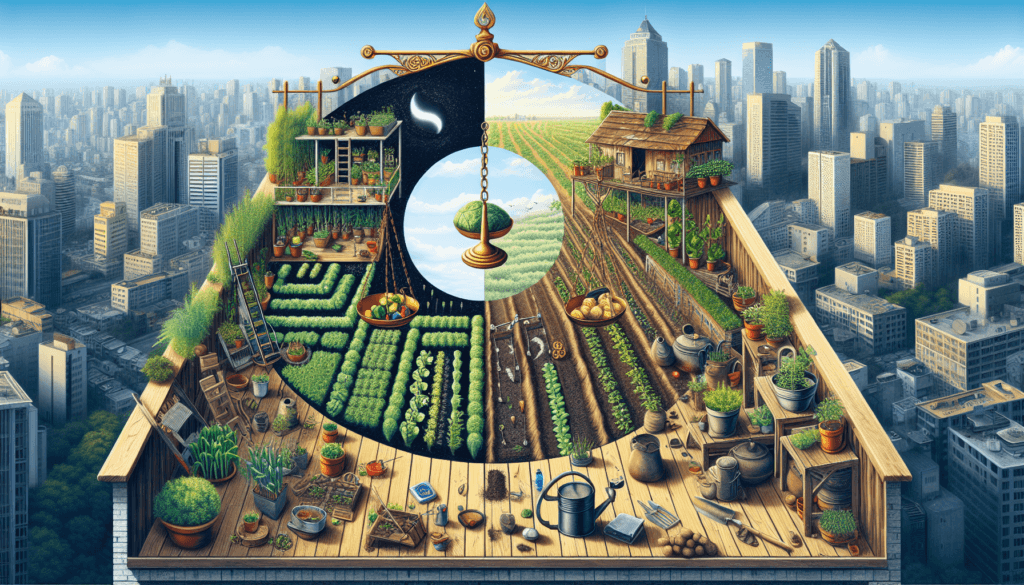Picture this: you’re standing in the middle of a bustling city, surrounded by towering skyscrapers and the constant hum of traffic. Yet, amidst all the concrete and steel, you spot a lush oasis – a vibrant garden bursting with life. This is the beauty of urban gardening, a rising trend that brings greenery and tranquility to urban landscapes. But how does it compare to traditional gardening, the tried-and-true method of cultivating plants in suburban or rural areas? In this article, we will explore the pros and cons of both approaches, shedding light on the benefits and challenges they bring. Whether you have a green thumb or are considering embarking on a gardening journey, this is a must-read to discover the possibilities that await you.

Benefits of Urban Gardening
Promotes sustainability in urban areas
Urban gardening plays a crucial role in promoting sustainability in urban areas. With the increasing urbanization and limited green spaces, urban gardening allows individuals to grow their own food in a sustainable and environmentally friendly manner. By utilizing vacant lots, rooftops, or even vertical spaces, urban gardening helps reduce the pressure on conventional farmland and the need for long-distance transportation of produce, ultimately leading to a reduced carbon footprint.
Maximizes limited space
One of the significant advantages of urban gardening is its ability to maximize limited space. In crowded urban areas, finding enough space for a traditional garden can be quite challenging. However, urban gardening techniques such as container gardening, vertical gardening, and rooftop gardening allow individuals to make the most of the available space. By utilizing innovative gardening methods, urban gardeners can grow a wide range of plants, from herbs and vegetables to flowers and even fruit trees, even in small apartment balconies or community gardens.
Improves air quality
Urban areas often suffer from poor air quality due to high levels of pollution, traffic, and industrial activities. Urban gardening can help improve this situation by acting as a natural air filter. Plants have the ability to absorb pollutants, including carbon dioxide, particulate matter, and volatile organic compounds, and release oxygen, effectively purifying the air. The presence of green spaces and vegetation in urban areas can significantly contribute to reducing air pollution and creating a healthier environment for the residents.
Enhances community engagement
Urban gardening provides a unique opportunity to engage and bring communities closer together. Whether it’s a community garden or local gardening initiative, urban gardening fosters a sense of belonging and encourages social interaction among neighbors. People with diverse backgrounds and interests can come together to share gardening knowledge, exchange tips, and build lasting relationships. This sense of community not only enhances the overall well-being of individuals but also strengthens social bonds and creates a support network within the neighborhood.
Provides fresh and organic produce
One of the most appealing aspects of urban gardening is the ability to grow your own fresh and organic produce. Unlike store-bought fruits and vegetables, which may have traveled long distances and undergone various stages of processing and preservation, urban gardeners have direct control over the quality and freshness of their harvest. By avoiding the use of chemical pesticides and relying on organic growing practices, urban gardeners can ensure that their produce is wholesome, nutritious, and free from harmful chemicals.
Reduces food and packaging waste
Urban gardening can significantly contribute to reducing both food and packaging waste. By growing your own food, you have better control over the quantity and harvesting time. This enables you to avoid overbuying, which often leads to food waste. Additionally, growing your own food can reduce the need for excessive packaging, such as plastic wrap or containers, which are commonly used in store-bought produce. By embracing urban gardening, you can play an active role in minimizing waste and promoting a more sustainable lifestyle.
Promotes physical and mental well-being
Engaging in urban gardening comes with a plethora of physical and mental health benefits. Spending time outdoors, tending to plants, and being in contact with nature have been linked to reduced stress levels, improved mood, and increased overall well-being. The physical activity involved in gardening, such as digging, planting, and harvesting, provides a low-impact workout that can contribute to maintaining a healthy weight and improving cardiovascular fitness. Additionally, gardening has been shown to enhance cognitive function and promote relaxation, making it an excellent activity for individuals looking to improve their mental health.

Challenges of Urban Gardening
Limited access to sunlight
One of the prominent challenges of urban gardening is limited access to sunlight. In densely built urban areas, buildings often cast shadows, obstructing the natural sunlight from reaching the plants. This can pose a significant challenge for gardeners who rely on sunlight for the growth and development of their plants. However, with innovative solutions such as vertical gardening or utilizing reflective surfaces to redirect sunlight, urban gardeners can overcome this obstacle and ensure their plants receive adequate light for healthy growth.
Limited access to water
Another challenge that urban gardeners face is limited access to water. In urban areas, water scarcity or restricted access to water sources can make it difficult to provide plants with the necessary amount of water they need to thrive. However, by adopting water-saving techniques such as drip irrigation systems, utilizing rainwater harvesting methods, or even recycling household wastewater, urban gardeners can maximize their water usage and ensure their plants receive the hydration they require.
Potential for soil contamination
Urban gardening carries the risk of soil contamination due to various factors, including pollution from nearby industrial sites, contaminated water sources, or the presence of heavy metals in urban soils. It is essential for urban gardeners to be aware of potential soil contamination issues and take appropriate measures to ensure the safety of their produce. This can include soil testing, using raised beds or containers with clean soil, and implementing proper soil management practices to minimize contamination risks.
Higher upfront costs
Compared to traditional gardening, urban gardening often comes with higher upfront costs. The need to invest in containers, soil, tools, and potentially specialized equipment for vertical or rooftop gardening can add up quickly. However, it is important to note that these costs can vary depending on the scale and complexity of the urban garden. While the initial investment may be higher, urban gardening can still be cost-effective in the long run, considering the savings on grocery bills and the potential for growing high-value crops that would be expensive to buy.
Maintenance and time commitment
Urban gardening requires consistent maintenance and a significant time commitment. Plants need to be regularly watered, fertilized, pruned, and protected from pests and diseases. In addition to these tasks, urban gardeners need to stay vigilant about monitoring plant health, managing soil quality, and addressing any issues that may arise. For individuals with busy schedules or limited time availability, the maintenance demands of urban gardening may prove challenging. However, efficient gardening techniques, such as choosing low-maintenance plants and utilizing time-saving tools, can help mitigate these challenges.
Risk of theft or vandalism
Urban gardening can be susceptible to theft or vandalism, especially in public or shared spaces. The presence of valuable and visible plants, such as fruit trees or high-yield vegetable crops, may attract unwanted attention. To address this concern, urban gardeners can take preventive measures such as installing fencing or protective structures, engaging the community in garden monitoring, or participating in neighborhood watch programs. Building a sense of ownership and pride within the community can act as a deterrence to potential theft or vandalism.
Potential zoning and legal restrictions
Urban gardening may be subject to potential zoning and legal restrictions, depending on local regulations and policies. Municipalities may have specific guidelines regarding the use of public spaces for gardening or restrictions on the size and height of structures used in vertical or rooftop gardening. It is crucial for urban gardeners to familiarize themselves with the local laws and regulations to ensure compliance and avoid any legal issues. By working closely with local authorities and engaging in dialogue, it is possible to advocate for more favorable policies and regulations that support urban gardening initiatives.

Advantages of Traditional Gardening
Abundance of sunlight and fresh air
Traditional gardening benefits from the abundance of sunlight and fresh air available in open spaces. By having larger, unrestricted areas for planting, traditional gardeners can take full advantage of natural light and air circulation, creating optimal conditions for plant growth. The unobstructed sunlight ensures that plants receive the necessary energy for photosynthesis, leading to healthier and more vigorous growth. Additionally, the free flow of fresh air helps prevent the buildup of moisture and reduces the risk of fungal diseases.
Access to larger gardening spaces
Traditional gardening provides access to larger gardening spaces, which allows for greater flexibility and diversity in plant selection. With ample room to plant a variety of crops, traditional gardeners can explore different cultivation techniques and experiment with a wider range of plants. This enables them to grow crops with varying sun and soil requirements, ensuring optimum conditions for each plant. The availability of more gardening space also enables the use of traditional gardening techniques, such as row planting or companion planting, which can enhance crop productivity and yield.
Greater control over soil quality
Traditional gardeners have greater control over the quality of their soil compared to urban gardeners. With access to larger areas of land, traditional gardeners can amend their soil according to specific plant needs, optimizing the nutrient content and pH levels. They can use organic matter, compost, or other soil amendments to improve soil structure, fertility, and water-holding capacity. This control over the soil composition allows traditional gardeners to provide an ideal growing environment for their plants, ultimately leading to healthier and more productive crops.
Lower upfront costs
One of the significant advantages of traditional gardening is the lower upfront costs involved. By utilizing an existing plot of land or backyard space, traditional gardeners can minimize the initial investment. They can utilize the natural soil and sunlight available, reducing the need for extra materials such as containers, soil mix, or specialized equipment. This affordability makes traditional gardening accessible to a wide range of individuals who may not have the financial means to invest in urban gardening setups.
Less maintenance and time commitment
Compared to urban gardening, traditional gardening requires less maintenance and time commitment. With larger planting areas and fewer space constraints, traditional gardeners can create more self-sustaining ecosystems that require minimal intervention. The larger spacing between plants also allows for better air circulation, which reduces the risk of plant diseases. Additionally, traditional gardening often benefits from natural pest control, as a diverse range of plants can attract beneficial insects that help manage pest populations. This reduced maintenance and lower time commitment make traditional gardening a more viable option for individuals with limited availability.
Traditional aesthetic appeal
Traditional gardening offers a timeless aesthetic appeal that many people find attractive. The visual appeal of a traditional garden, with its neatly arranged rows, flowers, and well-manicured lawns, can create a sense of tranquility and beauty. The traditional aesthetic can be a source of pride for gardeners and adds value to the overall aesthetics of the surrounding landscape. For individuals who value the classic and picturesque elements of gardening, traditional gardening provides a perfect avenue for expressing their creativity and creating a visually pleasing outdoor space.
No zoning or legal restrictions
Unlike urban gardening, traditional gardening is not typically subject to zoning or legal restrictions. In suburban or rural areas, homeowners often have the freedom to utilize their properties for gardening without being limited by specific regulations. This freedom allows gardeners to experiment with various gardening techniques, expand their gardens, or make changes that suit their gardening preferences. The absence of zoning or legal restrictions gives traditional gardeners more flexibility and creative control over their gardening endeavors.

Disadvantages of Traditional Gardening
Limited availability of gardening spaces in urban areas
One of the significant disadvantages of traditional gardening is the limited availability of gardening spaces in urban areas. As cities continue to expand and green spaces become scarce, individuals living in urban environments often lack the necessary land to create traditional gardens. This limitation forces urban dwellers to either forgo gardening or seek alternative methods, such as urban gardening, to fulfill their gardening aspirations.
Use of chemical pesticides and fertilizers
Traditional gardening has a historical reliance on chemical pesticides and fertilizers, which can have negative environmental impacts. In conventional practices, chemical pesticides are commonly used to control pests and diseases, while synthetic fertilizers are used to boost plant growth. However, the overuse or misuse of these chemicals can lead to water pollution, soil degradation, and harm beneficial insects and organisms. It is important for traditional gardeners to adopt organic and sustainable gardening practices to minimize the negative effects associated with chemical use.
Reliance on transportation for produce
Traditional gardening often involves a reliance on transportation for the distribution of produce. In suburban or rural areas, where traditional gardens are typically located, the distances to grocery stores or markets may be significant. This reliance on transportation increases the carbon footprint associated with the produce, contributes to traffic congestion, and may result in longer travel times for fresh food. It is important for traditional gardeners to explore local market options, participate in farmers’ markets, or support community-supported agriculture initiatives to minimize the need for long-distance transportation.
Greater risk of pests and diseases
Traditional gardening may face a greater risk of pests and diseases due to the larger, open spaces and the reliance on natural pest control methods. Without the controlled environment of urban gardens, traditional gardeners have to contend with a wider range of pests and diseases that can affect their crops. This risk can be managed through proper pest identification, regular monitoring, and the implementation of integrated pest management techniques. The traditional gardener’s ability to attract beneficial insects and establish a diverse ecosystem can also aid in managing pest populations.
Need for more water and resources
Traditional gardening typically requires more water and resources compared to urban gardening. With larger garden spaces, traditional gardeners may need to irrigate a larger area, resulting in higher water consumption. Furthermore, the use of conventional irrigation methods, such as sprinklers or hose watering, may lead to water wastage through evaporation or runoff. To address this challenge, traditional gardeners can explore water-saving techniques such as drip irrigation, mulching, or utilizing rainwater harvesting systems to reduce their water footprint and minimize resource usage.
Less community involvement
Unlike urban gardening, traditional gardening may have less community involvement due to the dispersed nature of traditional gardens. In suburban or rural settings, gardens are often spread out, making it more challenging for individuals to come together and engage in communal gardening activities. However, this does not mean that traditional gardeners cannot connect with like-minded individuals. Participating in local gardening clubs, attending gardening workshops or events, and joining online gardening communities can offer traditional gardeners avenues for connecting with fellow enthusiasts and sharing knowledge.
Higher waste generation
Traditional gardening may generate higher waste compared to urban gardening. With larger-scale operations and potentially more ambitious gardening projects, traditional gardeners may produce a higher volume of green waste, such as prunings, weeds, or fallen leaves. Proper waste management practices, such as composting or recycling, can help mitigate this issue and turn organic waste into valuable resources. By adopting a mindful approach to waste generation, traditional gardeners can minimize waste and create a more sustainable gardening practice.

Comparing Urban and Traditional Gardening
Space Utilization
Maximizing limited space is a key advantage of urban gardening. With innovative gardening techniques such as container gardening, vertical gardening, and rooftop gardening, urban gardeners can make the most of limited space in densely populated urban areas. These methods allow individuals to create beautiful and productive gardens even in small balconies, rooftops, or communal areas. On the other hand, traditional gardening benefits from the availability of larger gardening spaces, allowing for more extensive planting and diverse crop choices. The ample room in traditional gardens enables the use of traditional gardening techniques such as row planting or companion planting, further maximizing space utilization.
Environmental Impact
Both urban and traditional gardening have environmental benefits but in different ways. Urban gardening helps improve air quality by acting as a natural air filter, absorbing pollutants and reducing the carbon footprint associated with long-distance transportation of produce. The presence of green spaces in urban areas creates a healthier environment for residents. Traditional gardening benefits from the abundance of sunlight and fresh air available in open spaces, creating optimal conditions for plant growth. Furthermore, traditional gardening allows for greater biodiversity and the creation of self-sustaining ecosystems, positively impacting local flora and fauna.
Access to Sunlight and Resources
Limited access to sunlight is a common challenge in urban gardening due to the obstruction of sunlight by buildings or other structures. However, urban gardeners can overcome this limitation by utilizing reflective surfaces, vertical gardening structures, or choosing shade-tolerant plants. In contrast, traditional gardening benefits from an abundance of sunlight, as the unrestricted spaces allow plants to receive optimal sunlight throughout the day. Additionally, traditional gardening often has easier access to natural resources such as water sources, making it more convenient for plant hydration.
Produce Quality and Variety
Urban gardening provides the advantage of producing fresh and organic produce right at your doorstep. By avoiding the use of chemical pesticides and relying on organic growing practices, urban gardeners can ensure the quality and nutritional value of their harvest. Furthermore, the proximity to gardens allows for immediate consumption of freshly harvested produce, providing the ultimate farm-to-table experience. However, traditional gardening offers access to a larger variety of plants and crops. The availability of larger gardening spaces enables traditional gardeners to experiment with diverse plant species and explore a wider range of culinary and ornamental options.
Community and Social Aspects
Urban gardening is highly conducive to community engagement and social interaction. Community gardens and urban gardening initiatives bring people together, providing a platform for sharing knowledge, exchanging gardening tips, and building relationships with like-minded individuals. The shared gardening experience fosters a sense of camaraderie, creating a stronger sense of community among neighbors. Traditional gardening, while more dispersed, can also foster social connections. By participating in local gardening clubs, attending gardening events, or engaging with online gardening communities, traditional gardeners can connect with fellow enthusiasts and build supportive networks.
Costs and Maintenance
Urban gardening often comes with higher upfront costs due to the need for containers, specialized equipment, and soil mix. However, the long-term benefits of growing your own fresh produce can outweigh these initial expenses. Furthermore, urban gardening can be more cost-effective in terms of grocery savings and the potential for growing high-value crops. Traditional gardening, on the other hand, involves lower upfront costs as it utilizes existing land or backyard spaces, minimizing the need for extra materials. Additionally, traditional gardening generally requires less maintenance and time commitment due to larger spacing, natural pest control, and self-sustaining ecosystems.
Legal and Zoning Considerations
Urban gardening may face potential zoning and legal restrictions, especially in densely populated areas. Municipalities may have specific guidelines regarding the use of public spaces for gardening or restrictions on the size and height of structures used in urban gardening setups. It is important for urban gardeners to familiarize themselves with local laws and regulations to ensure compliance and avoid any legal hurdles. Traditional gardening, in most cases, is not subject to zoning or legal restrictions, as homeowners typically have the freedom to garden on their properties without specific regulations, fostering flexibility and creative control over their gardening endeavors.
In conclusion, both urban gardening and traditional gardening have their unique advantages and challenges. Urban gardening promotes sustainability in urban areas, utilizes limited space effectively, improves air quality, enhances community engagement, provides fresh and organic produce, reduces food and packaging waste, and promotes physical and mental well-being. However, it faces challenges such as limited access to sunlight, limited access to water, potential soil contamination, higher upfront costs, maintenance and time commitment, risk of theft or vandalism, and potential zoning and legal restrictions. On the other hand, traditional gardening benefits from an abundance of sunlight and fresh air, access to more gardening spaces, greater control over soil quality, lower upfront costs, less maintenance and time commitment, traditional aesthetic appeal, and no zoning or legal restrictions. However, it has disadvantages such as limited availability of gardening spaces in urban areas, use of chemical pesticides and fertilizers, reliance on transportation for produce, greater risk of pests and diseases, need for more water and resources, less community involvement, and higher waste generation. When comparing the two types of gardening, aspects such as space utilization, environmental impact, access to sunlight and resources, produce quality and variety, community and social aspects, costs and maintenance, and legal and zoning considerations should be taken into account to make an informed decision on which type of gardening suits individual preferences and circumstances.


